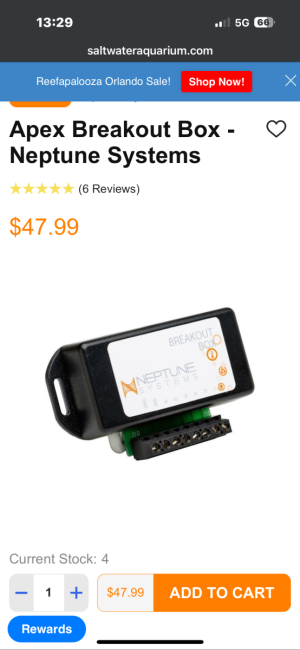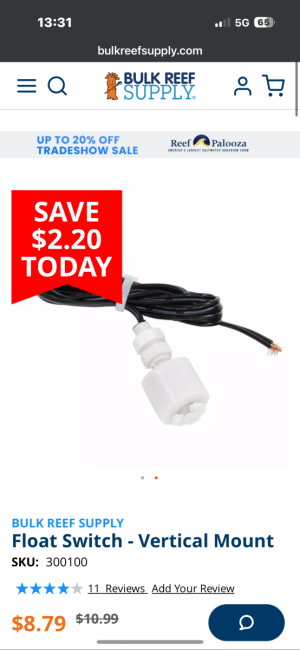So, I've got a check valve on the line to my fuge to prevent reverse-siphon (plus the return pipe outlet itself is just above water level).
BUT, while getting everything up and running the other night, I got called to walk the dog. Everything seemed to be working fine, so I stepped away...
and came back to water pouring off the top of the fuge and into my carpet.
Fortunately, it seemed to have just started by the time I came back to my office and it wasn't a whole boatload worth. Seemed the siphon hadn't started properly yet.
So, I need a mechanism to cut off my fuge pump (a cheap AquaNeat 160gph) when the water level gets too high.
I'd consider using the optical sensor made for my Apex, but the reviews on those are awful and say they fail without warning, typically within a year or two at most. They're not expensive, per se, but as someone who used to work in industrial liquid level measurement and gauging in some of the nastiest environments/liquids imaginable, I can say with some authority that a simple optical sensor in something as tame (by comparison) as saltwater should last MANY years with only the most basic care and maintenance.
So, I'm looking for a cost effective alternative. It doesn't have to play with my Apex at all, I just want something as a failsafe. I'd like something like the RODI Flood Guardian from XP Aqua, but it uses a solenoid meant for John Guest tubing, which is far too restrictive for my fuge pump (even dialed back to about ~40gph as I have it).
I'd like something like this, this, this or this, but none of them seem to be at all appropriate for marine use, with metal contact sensors that will inevitably corrode just hanging out 1/2" above the water level.
Hoping someone here might have a suggestion? Or should I just bite the bullet, spend the money on a pair of the optical sensors for the Apex (at $30) so I can have one as a backup, try sealing the ends of the cable with silicone, and plan on doing a regular maintenance check on it?
BUT, while getting everything up and running the other night, I got called to walk the dog. Everything seemed to be working fine, so I stepped away...
and came back to water pouring off the top of the fuge and into my carpet.
Fortunately, it seemed to have just started by the time I came back to my office and it wasn't a whole boatload worth. Seemed the siphon hadn't started properly yet.
So, I need a mechanism to cut off my fuge pump (a cheap AquaNeat 160gph) when the water level gets too high.
I'd consider using the optical sensor made for my Apex, but the reviews on those are awful and say they fail without warning, typically within a year or two at most. They're not expensive, per se, but as someone who used to work in industrial liquid level measurement and gauging in some of the nastiest environments/liquids imaginable, I can say with some authority that a simple optical sensor in something as tame (by comparison) as saltwater should last MANY years with only the most basic care and maintenance.
So, I'm looking for a cost effective alternative. It doesn't have to play with my Apex at all, I just want something as a failsafe. I'd like something like the RODI Flood Guardian from XP Aqua, but it uses a solenoid meant for John Guest tubing, which is far too restrictive for my fuge pump (even dialed back to about ~40gph as I have it).
I'd like something like this, this, this or this, but none of them seem to be at all appropriate for marine use, with metal contact sensors that will inevitably corrode just hanging out 1/2" above the water level.
Hoping someone here might have a suggestion? Or should I just bite the bullet, spend the money on a pair of the optical sensors for the Apex (at $30) so I can have one as a backup, try sealing the ends of the cable with silicone, and plan on doing a regular maintenance check on it?


